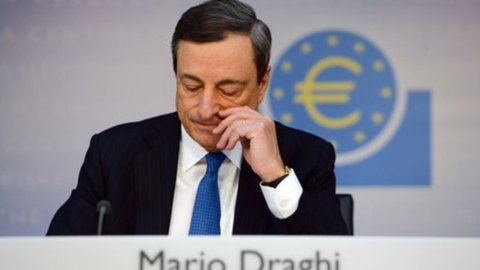“We believe that further monetary policy measures are needed and we are convinced that the purchasing program we are launching today is effective in raising inflation and bringing it close to but below 2%”. With these words the ECB President Mario Draghi kicked off today the highly anticipated Quantitative easing European, the bazooka which in everyone's hopes should revive the Eurozone by averting the specter of deflation, improving financing for the real economy and reinvigorating growth in the Old Continent. At least, that's what happened overseas where, thanks to the three Qe's from the Fed, the US economy is now growing at full speed.
And in the last call, Draghi dropped a heavy ace by launching a Qe that does not disappoint and indeed exceeds the expectations of the last few days. The ECB (which confirmed the rate at 0,05%) has in fact launched a program for the purchase of public and private debt securities worth a total of 60 billion euros per month which it intends to continue until at least September 2016. “In any case – Draghi specified in his introductory speech at the press conference – it will be conducted until we see a sustained adjustment in the path of inflation that is consistent with our objective of having inflation below, but close to 2% in the medium term”.
“In today's meeting – Draghi said – for the first time the council was unanimous in affirming that the purchase program is a true monetary policy instrument in the legal sense, therefore it is part of the weapons that the ECB can use. The council then decided by a large majority on the need to start it now and there was consensus on the final risk sharing at 20%”.
However, Draghi recalled, in the usual message he sends to governments, that "monetary policy can create the basis for growth but for this to occur, investments, trust and structural measures are needed". Now the ball passes to the Governments, the more they move in this direction the more they will make the ECB policy effective. “QE – Draghi specified – is not an incentive for governments to expand fiscally”.
HOW DRAGHI'S QE WORKS
The purchases will begin in March 2015 and, technically, this is the expansion of the already existing purchase program of ABS and covered bonds. In other words, now the ECB, in addition to these private securities, will also buy investment grade debt securities of the countries of the Euro area and of European agencies and institutions on the secondary market. The purchases will be based on the shares of the national central banks of the Eurosystem in the capital of the ECB.
Much awaited were the details on how to share or not the risks, with the distribution of hypothetical losses. A point that for Draghi has perhaps gained excessive attention and which, he said, “shouldn't be so important”. In detail, the ECB has decided that the purchase of securities of European institutions will be 12% of the additional purchases of assets, will be purchased by individual national central banks and will be subject to risk sharing. The rest of the purchases made by national central banks will not be subject to risk sharing.
The ECB overall will have 8% of the additional asset purchases. Which means that overall 20% of the additional asset purchases will be subject to a risk sharing regime. "A decision taken to mitigate the concerns of some", specified Draghi who explained how both risk sharing and non-risk sharing decisions were adopted in the ECB's past. In this context, Draghi explained, we must not forget that the OMT programme, where risk sharing is fundamental for the effectiveness of monetary policy, is always active and ready to be used.
At the same time, the conditions of the remaining six tranches of Tltro were changed, which will now apply an interest rate equal to the main refinancing rate in effect at the time of the auction.





